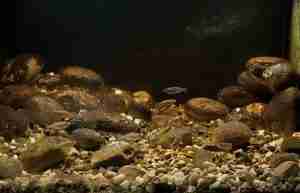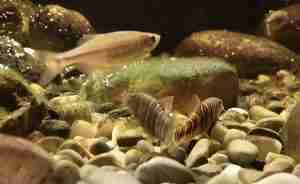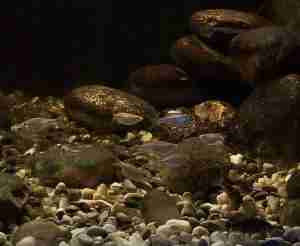Koyna and Krishna River Confluence Biotope
by Jeroen Vanhooren
 Biotope: Small tributary of the Koyna river near the confluence with Krishna river (India)
Biotope: Small tributary of the Koyna river near the confluence with Krishna river (India)
Dimensions: 70*50*35 (l*d*h)
Technical description
Lightning: 1 x Aquatlantis Easy Led 6800 K (28 W) – time controlled.
Filter: Internal sump with 2 sizes mechanical filtration media and a biological filtration medium. Pump with flow of 700 l/h used to circulate the water.
Substrate: light colored gravel combined with cobbles of different sizes.
Water change: Automatic with 2 episodes of adding fresh water each day by a dripping system.
 Water temperature: This stream is 23-27°C, depending on time of year with highest temperatures generally in pre-monsoon period. Water temperature is controlled by a aquarium heater of 200 W and will be variable during year.
Water temperature: This stream is 23-27°C, depending on time of year with highest temperatures generally in pre-monsoon period. Water temperature is controlled by a aquarium heater of 200 W and will be variable during year.
Plants: none
Fish: Botia striata and Devario aequipinnatusis
Biotope description: This aquarium simulates a small tributary of the Koyna river near the confluence with Krishna river. Koyna river originates near Mahabaleshwar and is one of the major tributaries to the Krishna river. Koyna River flows in a southward direction for about 65km, turns sharply eastwards at Helwak, in which direction it flows until its confluence with the Krishna River at Karad.
Stream velocity, temperature and pH in these streams are driven by monsoon. The water in this small stream that drains into Koyna river is well oxygenated and relatively soft.
 Temperature is fluctuating 23-27°C, pH 6,8-7,5. No macrophytes can be found in this system. River bottom consists of gravel and cobbles of different sizes.
Temperature is fluctuating 23-27°C, pH 6,8-7,5. No macrophytes can be found in this system. River bottom consists of gravel and cobbles of different sizes.
Botia striata and Devario aequipinnatusis live sympatric with several other fish species in these waters (Labeo porcellus, Puntius jerdoni, Rohtee ogilbii, Schismatorhynchos nukta, Tor khudree and Neotropius khavalcho and many, many more). Cyprindae are the dominant group with the beautiful endemic Puntius sahyadriensis, which seems to be dissapeared in the hobby.
Koyna river system is relatively less threathened by anthropogenic pressure, although fishing pressure, tourism and organic pollution in some parts of the river could not be neglected. A major part of the Koyna River backwaters is also protected by the Koyna Wildlife Sanctuary.
 Biotope One A Study of Flora and Fauna
Biotope One A Study of Flora and Fauna 


